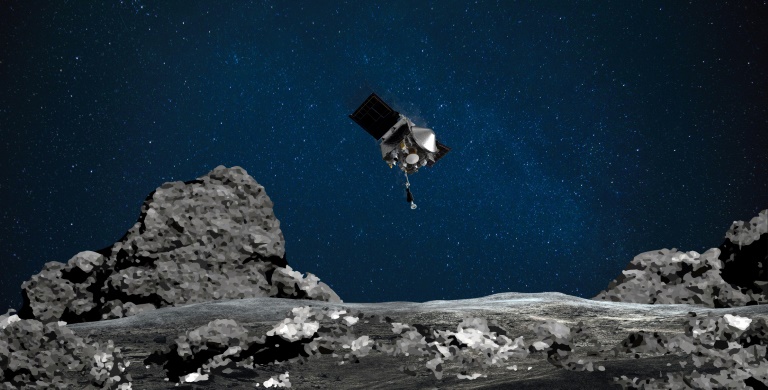
WASHINGTON: After a four-year journey, Nasa's robotic spacecraft Osiris-Rex briefly touched down on asteroid Bennu's boulder-strewn surface on Tuesday to collect rock and dust samples in a precision operation 330 million kilometres from Earth.
The so-called "Touch-And-Go" or TAG maneuver was managed by Lockheed Martin Space in Denver, Colorado, where at 6.12pm (5.12am Wednesday in Bangkok) an announcer said: "Touchdown declared. Sampling is in progress," and scientists erupted in celebration.
The historic mission was 12 years in the making and rested on a critical 16 second period where the spacecraft performed a delicate autonomous maneuver to grab its payload: at least 60 grams (two ounces), or a candy-bar sized amount of surface material that scientists hope will help unravel the origins of our solar system.
If Osiris-Rex successfully comes home in September 2023, it will have collected the largest sample returned from space since the Apollo era.
"We think we actually might be coming back with a baby picture of what the solar system was like, of what our chemistry was like, billions of years ago," Nasa scientist Michelle Thaller said.
"We're looking for our own origins out there, and that's why we've gone so far to bring a bit of Bennu back."
The spacecraft, about the size of a large van, slowed down to a crawl of just 10 centimetres per second on the final phase of its descent into the asteroid's Nightingale crater on the north pole of the asteroid, which is 490 metres in diameter.
It eased its robotic arm down to a target zone just eight metre in diameter, or equal to about three parking spaces, then fired pressurized nitrogen to agitate the surface material and catch its sample.
The spacecraft fired its thrusters to back away from Bennu's surface.
All of this occurred about 18.5 minutes earlier than announced, and the first images will only be available Wednesday once the probe is further away and has a higher data transmission rate.
It will be known on Saturday if Osiris-Rex succeeded in collecting the desired amount of dust.
Scientists want at least 60 grammes but the spacecraft is capable of picking up as much as two kilograms.
Beth Buck of Lockheed Martin explained that it's not possible to actually land on the asteroid, "so we will only be kissing the surface."
- 'Rosetta stone' -
Scientists are interested in analyzing the composition of the asteroids in the solar system because they are made of the same materials that formed the planets.
It's "almost a Rosetta stone, something that's out there and tells the history of our entire Earth, of the solar system during the last billions of years," said Nasa's chief scientist, Thomas Zurbuchen.
Laboratories on Earth will be able to carry out much more high powered analysis of their physical and chemical characteristics, said Naa's planetary science division director Lori Glaze.
Not all samples will be analyzed immediately, like those brought back from the Moon by the Apollo astronauts, which Nasa is still opening up 50 years later.
Nasa chose this particular asteroid because it is conveniently close and also ancient: scientists calculated that it formed in the first 10 million years of our solar system's history, 4.5 billion years ago.
After Osiris-Rex reached the rock at the end of 2018, the scientists were surprised to receive photographs showing that it was covered with pebbles and boulders sometimes 30 meters high.
Last year, Japan managed with its Hayabusa2 probe to collect some dust from another asteroid, Ryugu, and is now on its way home.